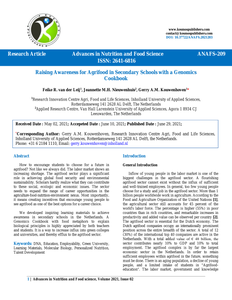The Dutch approach to genomics and society is taken as an example to show that the dream of achieving a symmetrical dialogue between social and bioscientists is not easily realized. Dutch social science and genomics experts aspired to create a bottom-up network for society and genomics that would enable social scientists to bring their own expertise and views into the dialogue with bioscientists. However, in the final stage of founding the network, this aspiration was nipped in the bud. As a result, the genomics and society research agenda has become primarily governed by the desire to adequately implement genomics in society.
DOCUMENT

How to encourage students to choose for a future in agrifood? Not like we always did. The labor market shows an increasing shortage. The agrifood sector plays a significant role in achieving global food security and environmental sustainability. Scholars hardly realize what they can contribute to these social, ecologic and economic issues. The sector needs to expand the range of career opportunities in the agriculture-food-nutrition-environment nexus. Most importantly, it means creating incentives that encourage young people to see agrifood as one of the best options for a career choice. We developed inspiring learning materials to achieve awareness in secondary schools in the Netherlands. A Genomics Cookbook with food metaphors to explain biological principles is highly appreciated by both teachers and students. It is a way to increase influx into green colleges and universities, and thereby efflux to the agrifood sector.
MULTIFILE

How to encourage students to choose for a future in agrifood? Not like we always did. The labor market shows an increasing shortage. The agrifood sector plays a significant role in achieving global food security and environmental sustainability. Scholars hardly realize what they can contribute to these social, ecologic and economic issues. The sector needs to expand the range of career opportunities in the agriculture-food-nutrition-environment nexus. Most importantly, it means creating incentives that encourage young people to see agrifood as one of the best options for a career choice.Inspiring learning materials have been developed to achieve awareness in secondary schools in the Netherlands. A Genomics Cookbook with food metaphors to explain biological principles is highly appreciated by both teachers and students. It is a way to increase influx into green colleges and universities, and thereby efflux to the agrifood sector.
DOCUMENT

The agrifood sector is crucial for achieving global food security and environmental sustainability. In the Netherlands, innovations in food technology and adjacent areas are achieved in attractive projects at Universities of Applied Sciences (UASs) in close interaction with government, industry, other knowledge institutes and society. By providing students central positions in innovative joint efforts that answer to the demands of small and medium sized enterprises, the curricula stay up to date and appealing. Examples of such efforts are the Food Innovation Academy (FIA), the World Horti Centre (WHC) and the Food Innovation Community Amsterdam (FICA). Interdisciplinary projects in these settings help to encourage students to choose for a future in agrifood. Exposure is key to reach the target groups. For that reason, several paths on the roadmap of the human capital agenda have to be taken. We developed inspiring learning materials that appeal to students and teachers in secondary schools. A “Genomics Cookbook” to introduce biological knowledge behind nutrigenomics and a velcro-model called “DNAbAND” to explain principles behind the Polymerase Chain Reaction for food safety applications, are examples. These are ways to increase influx into green colleges and universities, and thereby efflux to the agrifood sector.
DOCUMENT

What options are open for peoplecitizens, politicians, and other nonscientiststo become actively involved in and anticipate new directions in the life sciences? In addressing this question, this article focuses on the start of the Human Genome Project (1985-1990). By contrasting various models of democracy (liberal, republican, deliberative), I examine the democratic potential the models provide for citizens' involvement in setting priorities and funding patterns related to big science projects. To enhance the democratizing of big science projects and give citizens opportunities to reflect, anticipate, and negotiate on newdirections in science and technology at a global level, liberal democracy with its national scope and representative structure does not suffice. Although republican (communicative) and deliberative (associative) democracy models meet the need for greater citizen involvement, the ways to achieve the ideal at a global level still remain to be developed.
DOCUMENT

Genomics has multiplied the number of targets for new therapeutic interventions, but this has not yet lead to a marked increase of pharma pipeline outputs. The complexity of protein function in higher order biological systems is often underestimated. Translation from in vitro and in vivo results to the human setting frequently fails due to unforeseen toxicity and efficacy issues. Biosimulation addresses these issues by capturing the complex dynamics of interacting molecules and cells in mechanistic, predictive models. A central concept is that of the virtual patient, an encapsulation of a specific pathophysiological behaviour in a biosimulation model. The authors describe how virtual patients are being used in target identification, target validation and clinical development, and discuss challenges for the acceptance of biosimulation methods.
DOCUMENT
Het Genomisch kookboek is een boekje waarin moleculair biologische processen worden geïllustreerd met behulp van metaforen rondom koken.
MULTIFILE

Lezing over het gebrek aan aandacht voor vrouwen in de reproductieve genetica en het stamcelonderzoek.
DOCUMENT

Inaugurele rede voor de Universiteit van Maastricht met als onderwerp publieke gesprekken over gender en biotechnologie.
DOCUMENT
